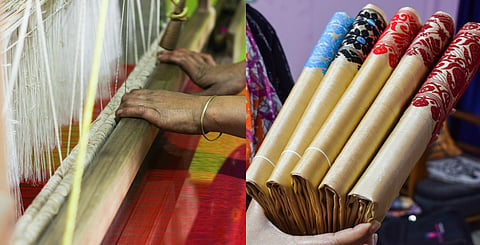
- Home
- Live Blog
- Breaking News
- Top Headlines
- Cities
- NE News
- Sentinel Media
- Sports
- Education
- Jobs

Staff Reporter
Guwahati: Although Assam has almost met the demand for Muga silk with local production, there is a huge gap between production and demand for Pat silk. While the demand for the GI-tagged Muga silk is 210 metric tonnes (MT), and the production was 202.83 MT in 2023-24, the demand for Pat silk is 300 MT, but the production was just 15.40 MT in 2023-24.
This was revealed by Handloom, Textiles, and Sericulture Minister Urkhao Gwra Brahma in the state Assembly in response to a question on the subject.
It is calculated that Assam produces only 5.13% of its total demand for Pat silk, whereas the state produces 96.58% of the Muga silk required.
"The shortfall in demand for Pat silk, around 285 MT, is met through imports from other states. Government agencies and private businesses import the required Pat silk in Assam. The import of Pat silk is done through ARTFED's Mulberry Yarn Bank in Sualkuchi," the minister stated in his reply.
He also said that as Muga silk is primarily produced in Assam, there is an effort to increase production of this GI-tagged silk through the implementation of schemes with the assistance of the Central Silk Board. A Silk Samagra scheme for integrated development of the silk industry is presently being implemented in Lakhimpur and Kamrup districts. Unfavourable weather and global warming have affected the production of Muga silk, as the silkworms are reared outdoors, it was pointed out.
A committee has also been formed by the Guwahati regional office of the Central Silk Board to identify comparatively cooler places in Assam and other Northeast states for better Muga silkworm rearing and the resultant production of Muga silk yarn. Directorates of Sericulture in all NE states have been roped in for the committee. The committee has taken up proposals for rearing Muga silkworms, according to the demand, in places with cooler climes. The reason for this is that the plain areas are hotter during the Assamese months of 'Ahar' and 'Bhado,' the usual time for rearing Muga silkworms in the state.
The Assam government had proposed the development of a hardier species of Muga silkworms, which will be able to withstand unfavourable weather, as global warming is making its presence felt here, and the Assam Agriculture University is now conducting research on this.
According to the information made available by the minister, there are 339 government silk farms in the state-with 203 in general areas and 136 in sixth schedule areas-under the Handloom, Textiles, and Sericulture department. Of the 339 silk farms, 121 are Eri farms, 86 are Muga, 127 are Pat, and 5 are Tasar silk farms.
Also Read: Advantage Assam 2.0 has brought hope to Muga, Eri and silk weavers
Also Watch: